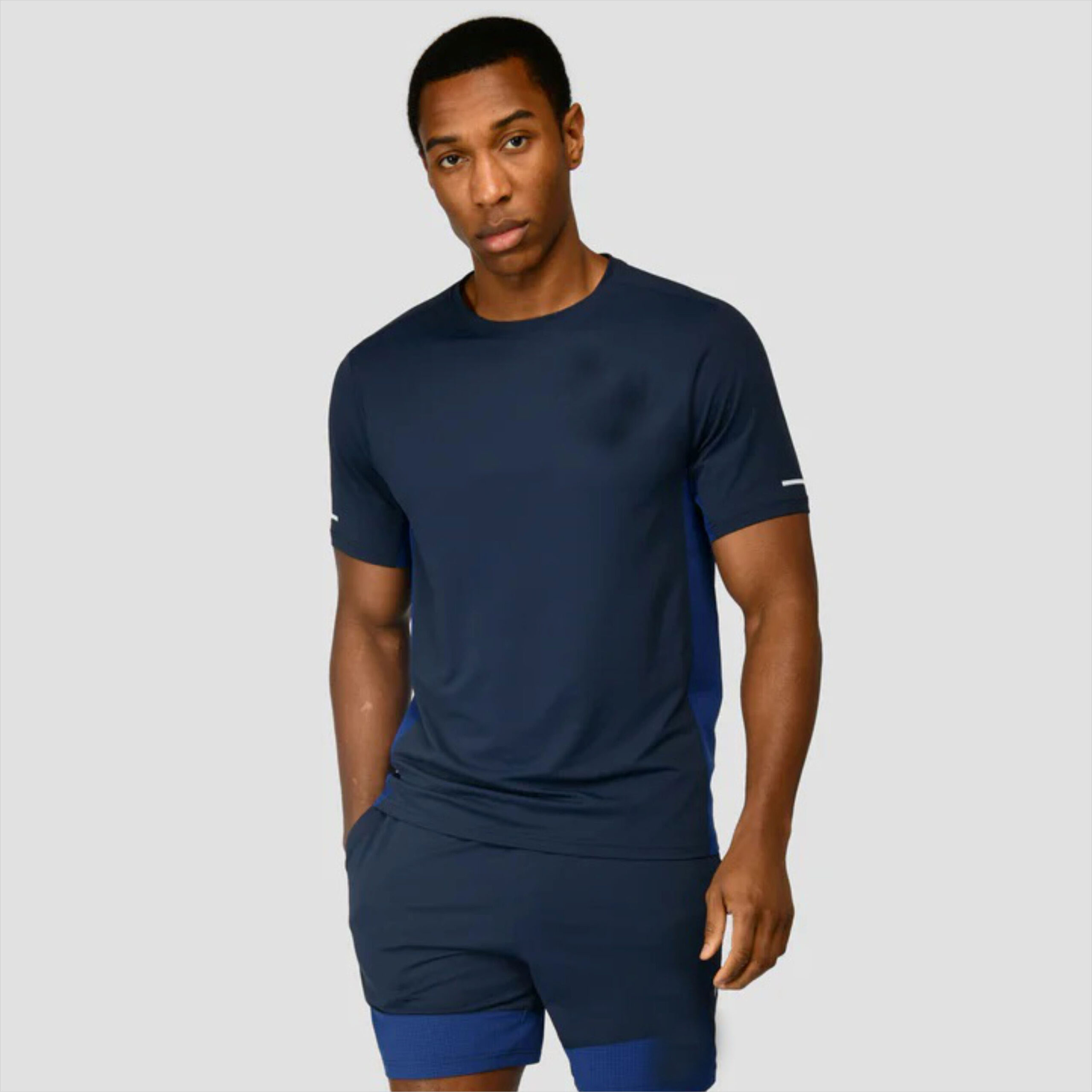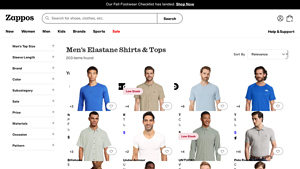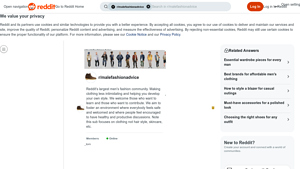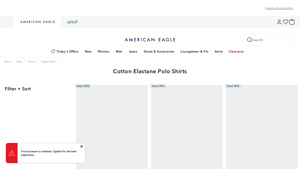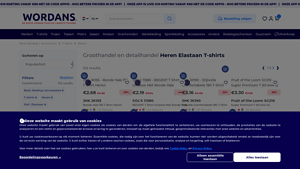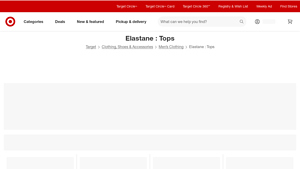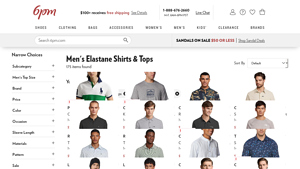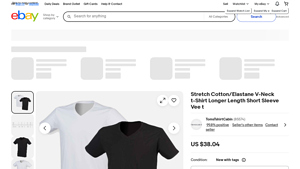Elastane Shirts: The Ultimate 2025 B2B Sourcing Guide
Introduction: Navigating the Global Market for elastane shirts
The global market for elastane shirts presents a unique challenge for B2B buyers seeking to source high-quality apparel that combines comfort and style. As businesses expand and diversify their offerings, understanding the nuances of elastane fabric—known for its exceptional stretch and flexibility—becomes crucial in meeting consumer demand. This guide is designed to equip international B2B buyers, particularly those from regions such as Africa, South America, the Middle East, and Europe, with the insights needed to make informed purchasing decisions.
Throughout this comprehensive resource, we will explore various types of elastane shirts, their applications across different sectors, and critical supplier vetting processes. We will also delve into pricing strategies, ensuring that buyers can navigate the cost landscape effectively. By addressing key considerations such as material quality, fit, and market trends, this guide empowers businesses to align their procurement strategies with market expectations.
Whether you are a retailer looking to enhance your product lineup or a distributor seeking reliable suppliers, understanding the intricacies of elastane shirts will enable you to make strategic choices that resonate with your target audience. This guide aims to facilitate a smoother sourcing process, ultimately enhancing your competitive edge in the dynamic global marketplace.
Understanding elastane shirts Types and Variations
| Type Name | Key Distinguishing Features | Primary B2B Applications | Brief Pros & Cons for Buyers |
|---|---|---|---|
| Stretch Cotton Dress Shirts | Blends cotton with elastane for comfort and breathability | Corporate attire, formal events | Pros: Comfortable, stylish; Cons: Higher price point compared to standard cotton. |
| Performance Polo Shirts | Moisture-wicking fabric with elastane for athletic use | Sports teams, promotional events | Pros: Functional for active wear; Cons: May not suit formal occasions. |
| Casual Short-Sleeve Shirts | Lightweight, stretchable fabric ideal for warm climates | Casual wear, hospitality industry | Pros: Versatile and comfortable; Cons: Less formal appearance. |
| Non-Iron Dress Shirts | Wrinkle-resistant properties, maintaining a sharp look | Business travel, everyday office | Pros: Low maintenance; Cons: Slightly less breathable than traditional fabrics. |
| Compression Tops | Tight-fitting, supportive design for sports and fitness activities | Fitness apparel, athletic teams | Pros: Enhances performance; Cons: May not be suitable for casual wear. |
What Are the Key Characteristics of Stretch Cotton Dress Shirts?
Stretch cotton dress shirts combine traditional cotton with elastane, providing a blend of comfort and flexibility. This type is particularly suitable for corporate environments and formal occasions, where a polished appearance is essential. When purchasing, B2B buyers should consider factors such as fabric weight, fit options, and color availability to ensure they meet the needs of their target audience.
How Do Performance Polo Shirts Stand Out in the Market?
Performance polo shirts are engineered with moisture-wicking properties and a stretchable fit, making them ideal for athletic and active environments. These shirts are commonly used in sports teams and promotional events, appealing to buyers looking for functional yet stylish apparel. Key considerations for B2B buyers include fabric technology, branding options, and the balance between comfort and performance.
Why Choose Casual Short-Sleeve Shirts for Warm Climates?
Casual short-sleeve shirts made from elastane blends are lightweight and designed for breathability, making them ideal for warmer climates. Their versatility allows them to be used in various settings, from casual wear to hospitality. Buyers should evaluate the quality of materials, color options, and price points to ensure they align with their brand’s image and customer preferences.
What Benefits Do Non-Iron Dress Shirts Provide for Busy Professionals?
Non-iron dress shirts offer the convenience of wrinkle resistance while maintaining a crisp appearance, making them a popular choice for business travel and everyday office wear. For B2B buyers, it’s essential to assess the durability of the fabric and the ease of care, as well as the fit options available to accommodate different body types and preferences.
How Do Compression Tops Enhance Athletic Performance?
Compression tops are designed to fit tightly against the skin, providing support during physical activities. They are often used in fitness apparel and by athletic teams looking to improve performance through enhanced blood circulation and muscle support. B2B buyers should consider the technical specifications, such as moisture management and breathability, to ensure the product meets athletes’ needs effectively.
Key Industrial Applications of elastane shirts
| Industry/Sector | Specific Application of elastane shirts | Value/Benefit for the Business | Key Sourcing Considerations for this Application |
|---|---|---|---|
| Corporate Apparel | Dress shirts for office wear | Enhances employee comfort and professionalism | Quality of fabric, durability, and fit customization |
| Hospitality | Uniforms for hotel staff and restaurant personnel | Promotes brand image and employee satisfaction | Breathability, stain resistance, and ease of care |
| Sports and Fitness | Activewear and performance shirts | Provides flexibility and moisture-wicking properties | Fabric technology, performance standards, and styles |
| Retail Fashion | Casual and formal wear for retail outlets | Attracts customers with stylish, comfortable options | Trend adaptability, fabric sourcing, and pricing |
| Healthcare | Scrubs and patient care uniforms | Ensures comfort and ease of movement for healthcare workers | Compliance with health standards, durability, and fit |
How Are Elastane Shirts Used in Corporate Apparel?
In the corporate sector, elastane shirts serve as a staple for professional attire, combining comfort with a polished appearance. Employees benefit from the stretchable fabric that allows for ease of movement, crucial for long hours in office settings. For international buyers, particularly from regions like Europe and the Middle East, sourcing high-quality elastane shirts involves ensuring the fabric meets local standards for durability and comfort while maintaining a professional look.
What Role Do Elastane Shirts Play in the Hospitality Industry?
In the hospitality industry, elastane shirts are commonly used as uniforms for staff in hotels and restaurants. These shirts enhance the overall brand image while providing staff with comfort during busy shifts. The breathable and stretchable nature of elastane fabric ensures that employees can perform their duties without feeling restricted. Buyers from regions such as Africa and South America should prioritize sourcing options that offer stain resistance and easy care to maintain a clean and professional appearance.
How Are Elastane Shirts Beneficial in Sports and Fitness?
Elastane shirts are essential in the sports and fitness industry, where they are designed for activewear and performance shirts. The fabric’s inherent stretch and moisture-wicking properties allow athletes to perform at their best without discomfort. B2B buyers in this sector must focus on sourcing elastane shirts that meet specific performance standards, including breathability and durability, to cater to the needs of fitness enthusiasts across various international markets.
Why Are Elastane Shirts Important in Retail Fashion?
In the retail fashion sector, elastane shirts are favored for both casual and formal wear. The combination of style and comfort attracts a diverse customer base, making them a valuable product for retailers. Sourcing elastane shirts requires an understanding of current fashion trends and consumer preferences, especially in regions like Europe, where style is paramount. Retailers should also consider the cost-effectiveness of their sourcing strategies to remain competitive.
How Do Elastane Shirts Enhance Healthcare Uniforms?
Elastane shirts are increasingly used in healthcare settings, particularly in scrubs and uniforms for patient care staff. The stretchable fabric allows healthcare workers to move freely while providing comfort during long shifts. For international buyers in the healthcare sector, it is crucial to ensure that sourced elastane shirts comply with health standards, offering durability and an appropriate fit for various body types. This focus on quality can significantly impact employee satisfaction and patient care.
3 Common User Pain Points for ‘elastane shirts’ & Their Solutions
Scenario 1: Sizing and Fit Issues in Bulk Orders of Elastane Shirts
The Problem: B2B buyers often face challenges with sizing and fit when ordering elastane shirts in bulk. Misunderstanding size specifications can lead to excess returns or exchanges, which not only incurs additional costs but also disrupts inventory management. This is particularly crucial for businesses in regions with diverse body types, where standard sizing may not cater to all customers. The repercussions include dissatisfied end customers and potential loss of sales if the products do not meet expectations.
The Solution: To mitigate sizing issues, B2B buyers should prioritize working closely with suppliers to obtain comprehensive size charts and fit guides that reflect the target market’s demographic. It’s advisable to request samples before placing large orders to ensure that the shirts meet the expected standards in terms of comfort and fit. Additionally, consider implementing a flexible return policy with suppliers to allow for adjustments based on customer feedback. Utilizing technology, such as 3D fitting solutions, can further enhance accuracy in sizing, helping to reduce errors before products reach the market.
Scenario 2: Fabric Durability and Care Instructions
The Problem: Another significant concern for B2B buyers is the durability of elastane shirts, especially in commercial environments where clothing is subjected to frequent washing and wear. Buyers may find that some elastane shirts lose their shape, color, or stretchability after a few washes, which can lead to customer dissatisfaction and increased replacement costs. Understanding the fabric’s care instructions is crucial, as improper maintenance can exacerbate these issues.
The Solution: Buyers should engage with suppliers to gain insight into the fabric composition and recommended care instructions of elastane shirts. Prioritize sourcing shirts made from high-quality blends that enhance durability while maintaining comfort. It’s beneficial to invest in training for end customers on proper care techniques, such as washing at lower temperatures and avoiding harsh detergents. Additionally, consider incorporating a care label or flyer with each shirt purchase that educates customers on the best practices to prolong the life of their elastane shirts.
Scenario 3: Limited Color and Style Options for Diverse Markets
The Problem: In many international markets, particularly in Africa and South America, B2B buyers may encounter a limited range of colors and styles for elastane shirts. This can hinder their ability to cater to local preferences and fashion trends, resulting in unsold inventory and missed sales opportunities. Buyers may feel pressured to conform to a narrow selection that does not resonate with their target audience, affecting brand image and customer loyalty.
The Solution: To overcome this challenge, B2B buyers should proactively communicate with manufacturers about the importance of offering a diverse range of colors and styles that reflect regional tastes. Conducting market research can provide valuable insights into local preferences and help inform design requests. Additionally, consider collaborating with local designers to create exclusive collections that appeal to specific markets. Building strong relationships with manufacturers who are willing to customize orders can enhance the product offering and strengthen market presence. Regularly reviewing and adjusting the product line based on customer feedback will also help ensure that the offerings remain relevant and appealing.
Strategic Material Selection Guide for elastane shirts
What Are the Key Materials Used in Elastane Shirts?
Elastane shirts are increasingly popular in the global market due to their unique blend of comfort, flexibility, and style. The choice of materials significantly impacts the performance and suitability of these garments for various applications. Below, we analyze several common materials used in elastane shirts, focusing on their properties, advantages, disadvantages, and considerations for international B2B buyers.
How Does Cotton Blend with Elastane Enhance Shirt Performance?
Cotton-Blend with Elastane is a popular choice for elastane shirts, offering a balance of breathability and stretch. Cotton provides excellent moisture absorption, making it comfortable in warm climates. The addition of elastane enhances flexibility, allowing for ease of movement without compromising the shirt’s fit.
Pros: Cotton-blend shirts are generally durable, soft, and comfortable against the skin. They are suitable for both casual and formal settings, making them versatile for various markets.
Cons: While cotton is durable, it can be prone to wrinkling and may require more care in terms of washing and ironing. The manufacturing process can also be complex, affecting production costs.
Impact on Application: Cotton-blend shirts are ideal for everyday wear, particularly in tropical regions of Africa and South America, where breathability is essential.
Considerations for International Buyers: Compliance with local textile standards, such as ASTM and DIN, is crucial. Buyers should also consider the garment’s care instructions, as these can vary significantly by region.
What Role Does Polyester Play in Elastane Shirt Production?
Polyester is another common fabric used in elastane shirts, known for its strength and resistance to shrinking and stretching. When blended with elastane, polyester enhances the shirt’s durability and maintains its shape over time.
Pros: Polyester is lightweight, quick-drying, and resistant to wrinkles, making it suitable for activewear and casual shirts. It offers a cost-effective solution for mass production.
Cons: Polyester is less breathable than natural fibers, which can lead to discomfort in hot climates. Additionally, it may not provide the same level of comfort as cotton.
Impact on Application: Polyester-blend elastane shirts are often used in sports and outdoor activities, appealing to markets in the Middle East and South America, where active lifestyles are prevalent.
Considerations for International Buyers: Buyers should be aware of environmental concerns related to polyester production and look for suppliers who adhere to sustainable practices.
How Does Nylon Contribute to the Performance of Elastane Shirts?
Nylon is a synthetic material that offers exceptional elasticity and strength. When combined with elastane, it creates a highly flexible fabric that is ideal for fitted styles.
Pros: Nylon is known for its durability and resistance to abrasion, making it suitable for high-performance applications. It also dries quickly, which is beneficial in humid climates.
Cons: The primary drawback of nylon is its lower moisture absorption compared to cotton, which may lead to discomfort during prolonged wear. It can also be more expensive than cotton or polyester.
Impact on Application: Nylon-elastane shirts are ideal for performance wear, particularly in regions with high humidity, such as parts of Africa and the Middle East.
Considerations for International Buyers: Compliance with international textile standards is essential, especially in Europe, where sustainability is a growing concern.
What Are the Advantages of Using Bamboo Fabric in Elastane Shirts?
Bamboo Fabric is an emerging option for elastane shirts, known for its eco-friendly properties. When blended with elastane, it offers a soft, breathable fabric that is suitable for sensitive skin.
Pros: Bamboo fabric is naturally antibacterial and moisture-wicking, making it comfortable for wear in hot climates. It is also biodegradable, appealing to environmentally conscious consumers.
Cons: The production process for bamboo fabric can be complex and costly, which may affect pricing. Additionally, its durability may not match that of synthetic fibers.
Impact on Application: Bamboo-elastane shirts are well-suited for casual and eco-friendly fashion markets, particularly in Europe and South America.
Considerations for International Buyers: Buyers should ensure that bamboo products meet local sustainability standards and certifications.
Summary Table of Material Selection for Elastane Shirts
| Material | Typical Use Case for elastane shirts | Key Advantage | Key Disadvantage/Limitation | Relative Cost (Low/Med/High) |
|---|---|---|---|---|
| Cotton-Blend | Casual and formal wear | Breathable and comfortable | Prone to wrinkling | Medium |
| Polyester | Activewear and casual shirts | Lightweight and quick-drying | Less breathable than cotton | Low |
| Nylon | Performance wear | High elasticity and durability | Lower moisture absorption | High |
| Bamboo Fabric | Eco-friendly fashion | Antibacterial and biodegradable | Higher production costs | Medium |
This strategic material selection guide provides B2B buyers with essential insights into the properties and applications of various materials used in elastane shirts, helping them make informed purchasing decisions tailored to their specific market needs.
In-depth Look: Manufacturing Processes and Quality Assurance for elastane shirts
What Are the Key Manufacturing Processes for Elastane Shirts?
The manufacturing of elastane shirts involves several critical stages, each designed to ensure the final product meets quality, comfort, and style requirements. Understanding these processes can empower B2B buyers to make informed decisions when sourcing from international suppliers.
How is Material Prepared for Elastane Shirts?
The first stage in manufacturing elastane shirts is material preparation. This involves selecting high-quality fabrics that typically combine cotton or polyester with elastane. The choice of blend affects not only the stretchability but also the shirt’s breathability and comfort.
-
Fabric Selection: Manufacturers often use stretch cotton or synthetic blends, which provide elasticity while ensuring durability. The fabric must also be pre-treated to enhance its properties, such as wrinkle resistance and colorfastness.
-
Fabric Cutting: Once the fabric is selected, it is cut into pattern pieces using automated cutting machines or manual methods, depending on the scale of production. This stage is crucial, as precise cutting ensures that all components fit together seamlessly during assembly.
What Techniques Are Employed in Forming and Assembling Elastane Shirts?
After preparation, the next steps involve forming and assembling the shirt.
-
Sewing Techniques: Modern manufacturing employs various sewing techniques, including overlocking and flatlock stitching, to ensure durability and comfort. These methods are essential for creating seams that can withstand the stress of stretching while maintaining a neat appearance.
-
Assembly Line Operations: The assembly is typically organized in an assembly line format, where workers or machines perform specific tasks to join the cut pieces. This method increases efficiency and reduces production time, allowing for higher output.
How Are Elastane Shirts Finished for Quality and Presentation?
Finishing processes play a vital role in the overall appeal of elastane shirts. This stage includes several steps to enhance the product’s appearance and functionality.
-
Washing and Treatment: After assembly, shirts undergo washing to remove any residual chemicals from the manufacturing process. This step may include treatments to enhance softness, anti-wrinkle properties, or color brightness.
-
Pressing and Quality Check: Finally, the shirts are pressed and undergo a quality check to ensure they meet specified standards. Any shirts that do not pass inspection are either reworked or discarded.
What Are the Quality Assurance Protocols for Elastane Shirts?
Quality assurance is a crucial aspect of the manufacturing process, particularly for elastane shirts that are designed for comfort and style. International standards and industry-specific guidelines ensure that products meet customer expectations.
Which International Standards Should B2B Buyers Consider?
B2B buyers should familiarize themselves with relevant international standards that apply to textile manufacturing. Key standards include:
-
ISO 9001: This standard outlines the requirements for a quality management system and is applicable across various industries, including textiles. Manufacturers certified under ISO 9001 demonstrate their commitment to consistent quality and customer satisfaction.
-
CE Marking: In the European market, CE marking indicates compliance with health, safety, and environmental protection standards. For elastane shirts, this ensures that the materials used are safe for consumer use.
-
Oeko-Tex Standard 100: This certification ensures that the textiles used are free from harmful substances. It is particularly relevant for elastane shirts, as it guarantees the safety of the fabric against skin irritations.
What Are the QC Checkpoints in the Manufacturing Process?
Quality control (QC) checkpoints are integral to maintaining product standards throughout the manufacturing process. Key checkpoints include:
-
Incoming Quality Control (IQC): This involves inspecting raw materials and components upon arrival at the manufacturing facility. Ensuring that materials meet specified standards is vital for the overall quality of the final product.
-
In-Process Quality Control (IPQC): During the manufacturing process, regular inspections are conducted to monitor the quality of work at various stages. This helps identify any issues early, allowing for timely corrections.
-
Final Quality Control (FQC): After production, a final inspection is conducted to assess the completed shirts for defects, sizing, and overall quality. This step ensures that only products meeting quality standards reach the market.
How Can B2B Buyers Verify Supplier Quality Assurance?
For international B2B buyers, verifying the quality assurance practices of potential suppliers is crucial. Here are some effective methods:
-
Supplier Audits: Conducting on-site audits allows buyers to assess the manufacturing processes, quality control systems, and compliance with international standards firsthand. This practice builds trust and ensures transparency in the supply chain.
-
Requesting Quality Reports: Buyers should request detailed quality reports, including results from IQC, IPQC, and FQC processes. These documents provide insight into the supplier’s commitment to maintaining quality throughout production.
-
Third-Party Inspections: Engaging third-party inspection agencies can provide an unbiased assessment of the supplier’s quality control practices. These agencies conduct thorough checks and offer certifications that can enhance the credibility of the supplier.
What Are the Nuances of QC and Certification for International B2B Buyers?
B2B buyers from different regions, particularly Africa, South America, the Middle East, and Europe, should be aware of specific nuances in quality control and certification:
-
Regional Regulations: Different markets have varying regulations regarding textile products. Buyers must ensure that suppliers comply with local regulations in their target markets, especially regarding health and safety standards.
-
Cultural Considerations: Understanding cultural preferences and expectations can impact product quality. For instance, preferences for fabric types or styles may vary significantly across regions, influencing the manufacturing process.
-
Sustainability Practices: Increasingly, buyers are looking for suppliers that adhere to sustainable practices. Certifications related to environmental management systems, such as ISO 14001, can be a key differentiator in supplier selection.
By understanding the manufacturing processes and quality assurance measures associated with elastane shirts, B2B buyers can confidently navigate the complexities of sourcing in a global market. This knowledge not only aids in selecting reliable suppliers but also ensures that the final products meet the high standards expected by consumers.
Practical Sourcing Guide: A Step-by-Step Checklist for ‘elastane shirts’
Introduction
Sourcing elastane shirts for your business can be a complex process, requiring careful consideration of various factors to ensure quality, fit, and supplier reliability. This checklist provides a structured approach for B2B buyers to navigate the sourcing process effectively. By following these steps, you can streamline your procurement strategy and make informed decisions that align with your business needs.
1. Define Your Technical Specifications
Start by outlining the specific requirements for the elastane shirts you wish to procure. Consider factors such as fabric composition, stretch percentage, sizing options, and color choices. Knowing your specifications helps in communicating effectively with potential suppliers and ensures that the final products meet your expectations.
- Fabric Blend: Decide the ratio of elastane to cotton or other materials for desired comfort and durability.
- Fit Type: Specify whether you need slim, regular, or relaxed fits based on your target market.
2. Identify Your Target Market
Understanding the demographics and preferences of your target audience is crucial in selecting the right styles and features. Consider regional trends, cultural preferences, and seasonal demands that may influence your product offerings.
- Market Research: Analyze competitors and consumer feedback to identify popular styles and colors.
- Seasonality: Plan for seasonal variations in demand, such as lighter fabrics for summer and heavier blends for winter.
3. Evaluate Potential Suppliers
Thoroughly vet potential suppliers to ensure they can meet your specifications and quality standards. Request company profiles, product samples, and references from other buyers to assess their reliability.
- Supplier Background: Check the supplier’s history, experience in the industry, and client testimonials.
- Product Samples: Request samples to evaluate fabric quality, fit, and overall craftsmanship.
4. Verify Compliance and Certifications
Ensure that your suppliers adhere to relevant industry standards and regulations. This is particularly important when sourcing from different regions, as compliance with labor laws and environmental regulations can vary significantly.
- Certification Checks: Look for certifications such as ISO, Oeko-Tex, or GOTS, which indicate adherence to quality and sustainability standards.
- Ethical Practices: Inquire about labor practices to ensure that your supply chain is responsible and ethical.
5. Negotiate Pricing and Terms
Once you have identified suitable suppliers, engage in negotiations regarding pricing, payment terms, and delivery schedules. Effective negotiation can lead to better pricing and terms that benefit your business.
- Bulk Discounts: Discuss potential discounts for large orders or long-term contracts.
- Payment Flexibility: Explore different payment options that can provide cash flow advantages.
6. Establish Quality Control Procedures
Implement a robust quality control process to ensure that the elastane shirts meet your specifications before they are shipped. This step is vital to maintain your brand’s reputation and minimize returns.
- Inspection Criteria: Define quality benchmarks, including stitching quality, color accuracy, and fit.
- Third-Party Audits: Consider hiring third-party inspectors for unbiased evaluations of product quality.
7. Plan for Logistics and Distribution
Finally, develop a logistics plan that addresses shipping, warehousing, and distribution of the elastane shirts. Efficient logistics will help you manage inventory levels and ensure timely delivery to your customers.
- Shipping Options: Evaluate different shipping methods based on cost, speed, and reliability.
- Warehouse Management: Consider how you will store and manage inventory to streamline order fulfillment.
By following this comprehensive sourcing checklist, B2B buyers can effectively navigate the complexities of procuring elastane shirts, ensuring they meet market demands while maintaining high-quality standards.
Comprehensive Cost and Pricing Analysis for elastane shirts Sourcing
What Are the Key Cost Components in Sourcing Elastane Shirts?
When sourcing elastane shirts, understanding the cost structure is vital for B2B buyers. The primary cost components include:
- Materials: The main fabric, typically a blend of cotton and elastane, significantly influences costs. High-quality elastane or specialty fabrics like Supima cotton can elevate prices.
- Labor: Labor costs vary by region and manufacturing practices. Countries with lower labor costs may offer more competitive pricing, but this can impact quality.
- Manufacturing Overhead: This encompasses factory expenses such as utilities, rent, and equipment maintenance. Factories with advanced technology may charge more but can offer better efficiency and product quality.
- Tooling: Initial costs for molds and patterns can be significant, particularly for custom designs. This cost is usually amortized over larger production runs.
- Quality Control (QC): Implementing stringent QC measures adds to costs but is essential for maintaining product standards, particularly for international markets.
- Logistics: Transportation costs, including shipping and customs, must be factored in, especially when importing to regions like Africa or South America, where logistics can be more complex.
- Margin: Suppliers will add a profit margin, which can vary significantly based on the supplier’s market position and the negotiated terms.
How Do Price Influencers Affect the Cost of Elastane Shirts?
Several factors can influence the pricing of elastane shirts for B2B buyers:
- Volume/MOQ: Minimum order quantities (MOQs) can drastically affect pricing. Higher volumes typically lead to lower unit costs, making bulk purchasing more cost-effective.
- Specifications and Customization: Custom designs or specific fabric blends can increase costs. Buyers should clearly communicate their requirements to avoid unexpected charges.
- Materials: The choice of materials directly impacts cost. Premium fabrics or those with certifications (like organic or sustainable) will usually be priced higher.
- Quality and Certifications: Products with certifications for quality or compliance with international standards (such as ISO) may carry a premium. Buyers should weigh the importance of these certifications against their budget.
- Supplier Factors: Long-standing relationships with suppliers can lead to better pricing and terms. Additionally, suppliers’ reputations for reliability and quality can influence pricing.
- Incoterms: The chosen Incoterms (International Commercial Terms) dictate the responsibilities of buyers and sellers in shipping and logistics. Understanding these terms is crucial for managing costs effectively.
What Tips Can Help B2B Buyers Negotiate Better Prices for Elastane Shirts?
B2B buyers can utilize several strategies to enhance their purchasing power and achieve better pricing:
- Negotiation: Engage in open discussions with suppliers about pricing, especially regarding volume discounts or long-term contracts. Building a rapport can often yield favorable terms.
- Cost Efficiency: Conduct a thorough analysis of the Total Cost of Ownership (TCO), which includes not just the purchase price but also shipping, handling, and potential returns. This holistic view can guide better purchasing decisions.
- Market Research: Understanding current market trends and competitor pricing can empower buyers during negotiations. This insight can help in justifying price expectations or exploring alternatives.
- Localized Sourcing: Consider sourcing from local suppliers to reduce logistics costs and tariffs, particularly when dealing with markets in Africa or South America, where import duties can be significant.
- Price Sensitivity Analysis: Determine the price elasticity of demand for your products. Understanding how changes in price affect your purchasing volume can inform your negotiation strategy.
Conclusion
The sourcing of elastane shirts involves a complex interplay of costs and pricing factors. By understanding the cost components, price influencers, and effective negotiation strategies, B2B buyers can make informed decisions that align with their business goals while ensuring they secure quality products at competitive prices. As always, it’s essential to approach these negotiations with a clear understanding of your requirements and market conditions, keeping in mind that prices are indicative and subject to change based on various factors.
Alternatives Analysis: Comparing elastane shirts With Other Solutions
Exploring Alternatives to Elastane Shirts: A Comparative Analysis
In the realm of professional apparel, elastane shirts are celebrated for their blend of comfort, flexibility, and style. However, businesses often seek alternatives that can provide similar benefits, whether for cost efficiency, specific use cases, or unique fabric properties. This analysis compares elastane shirts with two viable alternatives: polyester blend shirts and cotton-rich performance shirts.
| Comparison Aspect | Elastane Shirts | Polyester Blend Shirts | Cotton-Rich Performance Shirts |
|---|---|---|---|
| Performance | High stretchability and comfort | Good moisture-wicking properties | Breathable and soft, moderate stretch |
| Cost | Moderate to high ($35 – $150) | Generally lower ($20 – $70) | Moderate ($30 – $90) |
| Ease of Implementation | Widely available, easy to source | Readily available, diverse options | Common in retail and wholesale |
| Maintenance | Easy care, typically machine washable | Durable, retains shape well | May require more care, prone to wrinkles |
| Best Use Case | Business casual, outdoor events | Activewear, casual settings | Everyday wear, office environments |
What Are the Pros and Cons of Polyester Blend Shirts?
Polyester blend shirts are often favored in activewear due to their excellent moisture-wicking capabilities. These shirts can keep the wearer dry and comfortable during physical activity, making them suitable for sports or casual outings. The cost of polyester shirts is generally lower than elastane options, which can be a significant advantage for bulk purchases. However, they may lack the same level of stretch and comfort, potentially leading to a less polished appearance in professional settings.
How Do Cotton-Rich Performance Shirts Compare?
Cotton-rich performance shirts combine the natural softness of cotton with performance-enhancing properties. They are breathable and comfortable, making them ideal for everyday office wear. While they provide moderate stretch, they may not match the flexibility of elastane shirts. Their maintenance can be more demanding, as they may wrinkle easily and require ironing. Nevertheless, they appeal to buyers looking for a more traditional fabric feel while still benefiting from performance features.
Conclusion: How to Choose the Right Shirt Solution for Your Business Needs?
When selecting the appropriate shirt solution, B2B buyers should consider their specific requirements, including the intended use, budget constraints, and maintenance preferences. Elastane shirts are ideal for businesses seeking a professional look with comfort, while polyester blends are excellent for performance-oriented applications. Cotton-rich options serve well for those prioritizing natural fabrics with everyday wearability. By assessing these factors, buyers can make informed decisions that align with their operational needs and target market.
Essential Technical Properties and Trade Terminology for elastane shirts
What Are the Key Technical Properties of Elastane Shirts?
When sourcing elastane shirts, understanding the technical specifications is crucial for making informed purchasing decisions. Here are some essential properties to consider:
1. Material Composition
Elastane, also known as spandex or Lycra, is a synthetic fiber known for its exceptional elasticity. Typically blended with cotton or polyester, elastane content in shirts usually ranges from 2% to 10%. This blend enhances comfort and flexibility, making it ideal for active wear and formal attire alike. Buyers should evaluate the percentage of elastane to ensure optimal stretch and durability, which are vital for maintaining the shirt’s shape over time.
2. Fabric Weight
Fabric weight is measured in grams per square meter (GSM) and significantly impacts the shirt’s feel and performance. Lighter fabrics (100-150 GSM) are often preferred for casual wear and summer collections, while heavier fabrics (150-250 GSM) are suitable for winter or formal shirts. Understanding fabric weight helps buyers select appropriate garments for specific climates and occasions, ensuring customer satisfaction.
3. Shrinkage Rate
The shrinkage rate indicates how much a fabric may shrink after washing and drying. For elastane shirts, a low shrinkage rate (typically under 5%) is desirable to maintain size and fit. Buyers should inquire about the manufacturer’s pre-treatment processes to minimize shrinkage, which can affect inventory management and customer returns.
4. Color Fastness
Color fastness refers to the resistance of a fabric’s color to fading or running during washing or exposure to light. This property is measured against various standards, such as ISO or AATCC. High color fastness is essential for maintaining the visual appeal of elastane shirts, especially in regions with high sunlight exposure. Buyers should prioritize suppliers who adhere to rigorous testing standards for color retention.
5. Breathability
Breathability is a critical property for comfort, particularly in warmer climates. Fabrics that allow moisture to escape while permitting air circulation enhance wearer comfort. Elastane blends can vary in breathability based on the proportion of natural fibers used. Buyers should evaluate this property to ensure that the shirts meet the comfort needs of their target market.
What Are Common Trade Terminology and Concepts Relevant to Elastane Shirts?
Understanding industry jargon is vital for effective communication and negotiation in B2B transactions involving elastane shirts. Here are key terms to be familiar with:
1. OEM (Original Equipment Manufacturer)
OEM refers to a company that produces parts or products that are sold under another company’s brand. In the context of elastane shirts, buyers may work with OEMs to create custom designs or specifications tailored to their market needs. Understanding OEM relationships can help buyers negotiate better terms and control quality.
2. MOQ (Minimum Order Quantity)
MOQ indicates the smallest number of units a supplier is willing to sell. This figure is crucial for buyers to understand their initial investment and inventory management. Assessing MOQ can help businesses align their purchasing strategy with market demand and financial capabilities.
3. RFQ (Request for Quotation)
An RFQ is a document sent to suppliers requesting pricing and terms for a specific quantity of products. When considering elastane shirts, submitting an RFQ allows buyers to compare costs and conditions from different manufacturers, facilitating informed decision-making.
4. Incoterms (International Commercial Terms)
Incoterms are standardized trade terms that define the responsibilities of buyers and sellers regarding shipping, insurance, and tariffs. Familiarity with Incoterms is essential for B2B buyers operating internationally, as they determine costs and liabilities associated with the delivery of elastane shirts.
5. Lead Time
Lead time is the period between placing an order and receiving it. This term is particularly relevant in the fashion industry, where timely delivery can impact sales. Understanding lead times helps buyers manage inventory levels and customer expectations effectively.
By grasping these essential technical properties and trade terminologies, B2B buyers can navigate the elastane shirt market more effectively, ensuring they select products that meet their specific needs while fostering successful supplier relationships.
Navigating Market Dynamics and Sourcing Trends in the elastane shirts Sector
What Are the Key Market Trends Impacting the Elastane Shirts Sector?
The elastane shirts market is experiencing dynamic shifts driven by several global factors. The rise in demand for comfortable yet stylish apparel, particularly in the business casual sector, is a key driver. International buyers from Africa, South America, the Middle East, and Europe are increasingly seeking products that blend aesthetic appeal with functionality, leading to a greater emphasis on performance fabrics. Emerging trends include the adoption of advanced textile technologies that enhance stretchability and breathability, making elastane shirts suitable for both formal and informal occasions.
Moreover, the growing influence of e-commerce is reshaping how B2B buyers source elastane shirts. Platforms that offer a wide range of options, including customizable features, are gaining traction. Buyers are also leveraging data analytics to make informed purchasing decisions, ensuring they align with current fashion trends and consumer preferences. Another noteworthy trend is the increasing popularity of athleisure styles, which combine casual wear with active performance features, appealing to a broader demographic.
How Are Sustainability and Ethical Sourcing Reshaping the Elastane Shirts Market?
Sustainability is becoming a crucial factor in the sourcing of elastane shirts. With increasing awareness of environmental impacts, buyers are now prioritizing suppliers that demonstrate commitment to ethical sourcing practices. This includes utilizing eco-friendly materials, such as organic cotton blended with elastane, and ensuring that production processes minimize water usage and carbon emissions.
Moreover, certifications like Global Organic Textile Standard (GOTS) and OEKO-TEX are gaining importance among B2B buyers as they seek assurance of sustainable practices in their supply chains. Ethical sourcing not only enhances brand reputation but also meets the growing consumer demand for transparency. As markets in Africa, South America, and the Middle East evolve, international buyers are encouraged to engage with suppliers who are not just cost-effective but also environmentally responsible, fostering a sustainable future for the elastane shirts sector.
What Is the Historical Context of Elastane in Shirt Manufacturing?
The history of elastane, also known as spandex or Lycra, dates back to the 1950s when it was developed as a synthetic fiber. Initially utilized in the manufacturing of athletic wear due to its exceptional elasticity, elastane quickly found its way into everyday garments, including shirts. By the 1980s, the incorporation of elastane in dress shirts revolutionized men’s fashion, providing a comfortable fit without compromising on style.
Over the decades, advancements in textile technology have further enhanced the properties of elastane, allowing for improved durability and comfort. Today, elastane shirts are a staple in both casual and formal wardrobes, representing a blend of tradition and innovation. As international B2B buyers look to source these garments, understanding the evolution of elastane can provide insights into its growing significance in modern apparel manufacturing.
Frequently Asked Questions (FAQs) for B2B Buyers of elastane shirts
-
How do I choose the right elastane shirt supplier?
When selecting a supplier for elastane shirts, consider their experience in the textile industry, especially with stretch fabrics. Request samples to assess the quality of materials and craftsmanship. Verify their production capacity to meet your order size and timelines. Additionally, check for certifications that indicate compliance with international standards, such as ISO or OEKO-TEX, which can ensure product safety and sustainability. Finally, read reviews and testimonials from other B2B clients to gauge their reliability and service level. -
What is the best elastane shirt for corporate branding?
The best elastane shirt for corporate branding typically features a classic fit with a smooth surface for easy printing or embroidery. Look for options with a higher percentage of elastane blended with cotton, as this provides comfort and durability, making it suitable for professional settings. Select neutral colors that align with your brand’s palette to ensure the logo stands out. Consider lightweight and breathable fabrics for warmer climates, ensuring employees remain comfortable throughout the day. -
What are the minimum order quantities (MOQs) for elastane shirts?
Minimum order quantities for elastane shirts can vary significantly depending on the supplier. Generally, MOQs range from 100 to 1,000 pieces per style, color, and size combination. Some manufacturers may offer lower MOQs for sample orders or specific promotional runs. It’s advisable to discuss your needs upfront and negotiate terms that align with your business strategy, especially if you are a startup or entering new markets. -
How can I customize elastane shirts for my business?
Customization options for elastane shirts typically include selecting colors, adding logos or branding, and choosing specific styles or fits. Many suppliers offer a design service where you can collaborate on creating unique patterns or designs. Ensure to provide clear specifications and artwork files in the required formats. Discuss lead times for custom orders, as they may differ from standard items, and confirm any additional costs associated with customization. -
What payment terms should I expect when ordering elastane shirts?
Payment terms for ordering elastane shirts vary by supplier but typically include options such as a deposit upfront (commonly 30-50%) with the balance due upon delivery or before shipment. Some suppliers may offer net 30 or net 60 terms for established businesses. It’s crucial to clarify payment methods accepted (e.g., bank transfer, credit card, PayPal) and any fees associated with international transactions. Always ensure that terms are documented in your purchase agreement to avoid misunderstandings. -
What quality assurance (QA) practices should I look for in elastane shirts?
Quality assurance practices are essential when sourcing elastane shirts. Look for suppliers that conduct thorough inspections at various stages of production, including raw material sourcing, during manufacturing, and before shipment. Request information on their quality control processes, including testing for fabric stretch, durability, and colorfastness. Suppliers with certifications from recognized bodies often adhere to higher standards, reducing the risk of defects in the final product. -
What logistics considerations should I be aware of when importing elastane shirts?
When importing elastane shirts, consider shipping methods, customs regulations, and potential tariffs that apply to your destination country. Work with logistics partners who specialize in textile imports to navigate these complexities efficiently. Ensure that the supplier provides accurate documentation, such as invoices and packing lists, to facilitate smooth customs clearance. Additionally, factor in lead times for production and shipping to align with your inventory needs. -
How do I handle returns or exchanges for elastane shirts?
Handling returns or exchanges for elastane shirts requires a clear policy agreed upon with your supplier. Establish guidelines on acceptable reasons for returns, such as defects or incorrect orders. Discuss the process for initiating returns, including timelines and who bears the shipping costs. Having a written return policy can streamline this process and build trust between you and your supplier, ensuring that both parties understand their responsibilities.
Important Disclaimer & Terms of Use
⚠️ Important Disclaimer
The information provided in this guide, including content regarding manufacturers, technical specifications, and market analysis, is for informational and educational purposes only. It does not constitute professional procurement advice, financial advice, or legal advice.
While we have made every effort to ensure the accuracy and timeliness of the information, we are not responsible for any errors, omissions, or outdated information. Market conditions, company details, and technical standards are subject to change.
B2B buyers must conduct their own independent and thorough due diligence before making any purchasing decisions. This includes contacting suppliers directly, verifying certifications, requesting samples, and seeking professional consultation. The risk of relying on any information in this guide is borne solely by the reader.
Top 8 Elastane Shirts Manufacturers & Suppliers List
1. Zappos – Shirts & Tops
Domain: zappos.com
Registered: 1999 (26 years)
Introduction: This company, Zappos – Shirts & Tops, is a notable entity in the market. For specific product details, it is recommended to visit their website directly.
2. lululemon – Elastane Polo Shirt
Domain: shop.lululemon.com
Registered: 1999 (26 years)
Introduction: {“name”: “Elastane Polo Shirt”, “brand”: “lululemon”, “material”: [“elastane”, “jersey fabric”, “mid-weight cotton fabric”], “sizes”: [“XS”, “S”, “M”, “L”, “XL”, “XXL”], “colors”: [“Black”, “Blue”, “Green”, “Grey”, “Navy”, “White”], “gender”: [“Men”, “Women”], “collection”: [“Metal Vent Tech”, “Soft Jersey”], “activities”: [“Casual”, “Golf”, “Tennis”, “Travel”, “Work”], “seasons”: [“Fall”, “Summer…
3. American Eagle – Flex Button Down Shirts
Domain: reddit.com
Registered: 2005 (20 years)
Introduction: Casual shirts with elastane/stretch for athletic fit; important for individuals with a 43″ chest and 33″ waist; looking for styles such as gingham, floral, stripe; suggestions include American Eagle Flex Button Down Shirts; located in Canada, indicating fewer options.
4. AE – Cotton Elastane Polo Shirts
Domain: ae.com
Registered: 1999 (26 years)
Introduction: Cotton Elastane Polo Shirts available in various styles including AE 24/7 Club Logo Polo Shirt, AE Lived-In Stretch Pique Slim Fit Tipped Polo Shirt, AE Lived-In Slim Fit Pique Polo Shirt, AE Club Pique Polo Shirt, AE Boxy Stretch Pique Polo Shirt, AE Lived-In Jersey Polo Shirt, and AE Weekend Striped Button-Up Sweater Polo Shirt. Prices range from $8.98 to $47.45 with discounts up to 70% off. Siz…
5. Gildan – Men’s Elastane T-Shirts
Domain: wordans.com
Registered: 2006 (19 years)
Introduction: 7 cheap Men Elastane T-Shirts at wholesale prices | Weight: 195g/m² and over | Price Range: $2.51 – $4.36 | Brands: Gildan, Next Level | Types: Crew Neck, V-neck, Short sleeves, Long sleeves | Customization options available | Made in USA | High stock availability | Suitable for sublimation and thermal wash.
6. Target – Elastane Men’s Shirts and Tops
Domain: target.com
Introduction: Elastane men’s shirts and tops available at Target include a variety of styles such as T-shirts, polo shirts, short-sleeve shirts, long-sleeve shirts, tank tops, and hoodies. Options for slim-fit shirts and tees are available for a tailored look. Formal options include button-down and button-up shirts for special occasions. For workouts, moisture-wicking T-shirts are offered. Long-sleeve t-shirts …
7. Polo Ralph Lauren – Custom Slim Fit Stretch Oxford Mesh Polo
Domain: 6pm.com
Registered: 2004 (21 years)
Introduction: [{“Brand Name”:”Polo Ralph Lauren”,”Product Name”:”Custom Slim Fit Stretch Oxford Mesh Polo”,”Gender”:”Men’s”,”Color”:”Cruise Green Multi”,”Price”:”$75.90″,”MSRP”:”$138.00″,”Discount”:”45% off”},{“Brand Name”:”Columbia”,”Product Name”:”Kwick Hike™ Graphic Short Sleeve Tee”,”Gender”:”Men’s”,”Color”:”Boulder Heather/Tested Tough PDX”,”Price”:”$14.00″,”MSRP”:”$35.00″,”Discount”:”60% off”},{“Brand Nam…
8. Stretch Cotton – V-Neck T-Shirt
Domain: ebay.com
Registered: 1995 (30 years)
Introduction: {“Product Name”: “Stretch Cotton/Elastane V-Neck T-Shirt Longer Length Short Sleeve Vee t”, “Condition”: “New with tags”, “Size Options”: [“S”, “M”, “L”, “XL”, “XXL”], “Color Options”: [“Black”, “White”], “Quantity Available”: 30, “Price”: “$38.04”, “Shipping”: “Free shipping and returns”, “Returns Policy”: “60 days returns, seller pays for return shipping”, “Seller”: {“Name”: “TomsTshirtCabin”, “…
Strategic Sourcing Conclusion and Outlook for elastane shirts
In the evolving landscape of apparel manufacturing, the strategic sourcing of elastane shirts presents a unique opportunity for B2B buyers across diverse markets, including Africa, South America, the Middle East, and Europe. The fusion of comfort, durability, and style inherent in elastane fabrics caters to a growing demand for versatile clothing that transitions seamlessly from professional settings to casual outings. By prioritizing quality and supplier reliability, businesses can enhance their brand reputation and customer loyalty.
Moreover, understanding regional preferences and market trends is crucial. For instance, European markets may lean towards tailored fits and premium materials, while buyers in the Middle East and Africa might prioritize functionality and breathability in hot climates. Strategic partnerships with manufacturers who can deliver on these specific needs will be key to maintaining competitive advantage.
Looking ahead, now is the time for international B2B buyers to capitalize on the growing demand for elastane shirts. By sourcing strategically, companies can not only optimize their supply chains but also align with consumer trends that favor comfort without compromising on style. Engage with reliable suppliers and explore innovative designs to elevate your product offerings and meet the diverse needs of your clientele.
